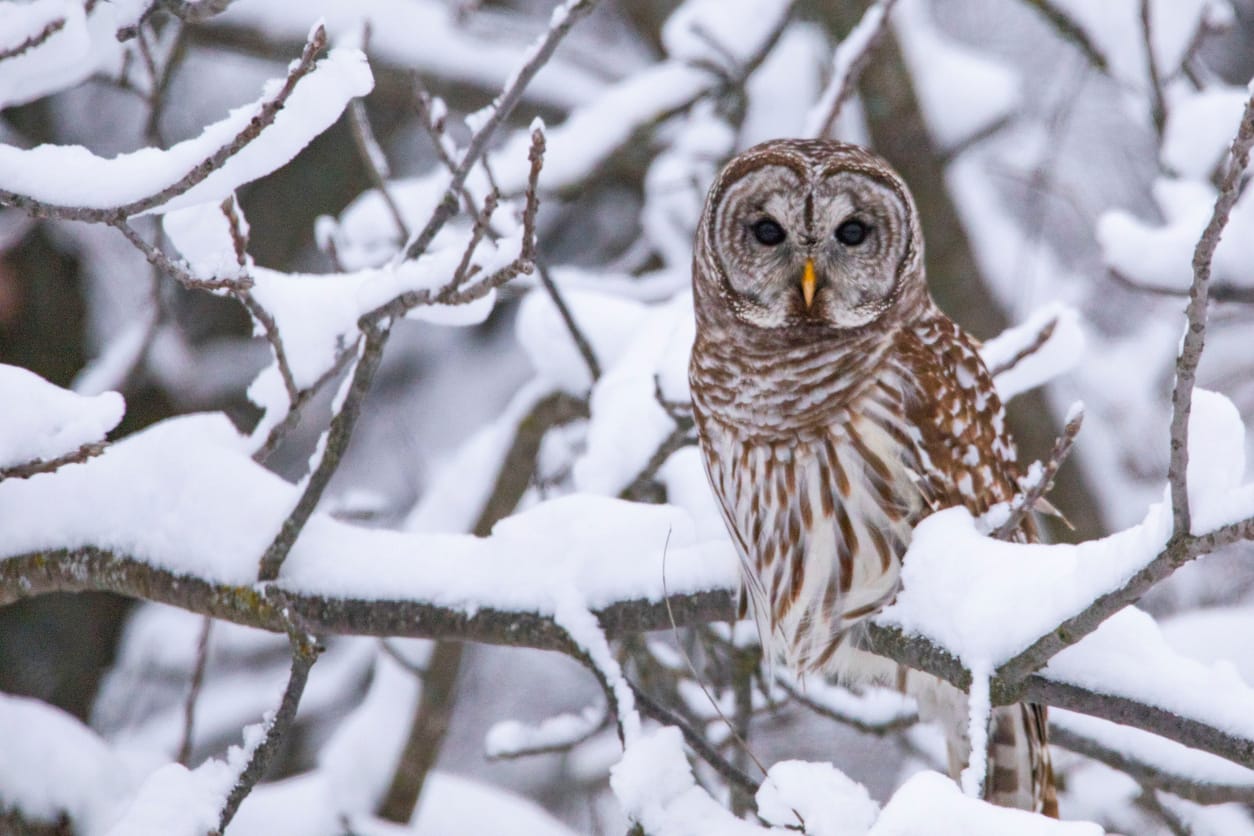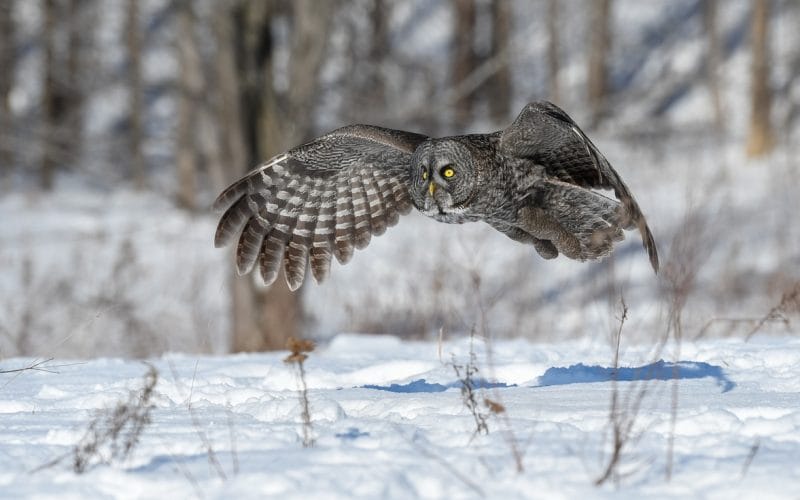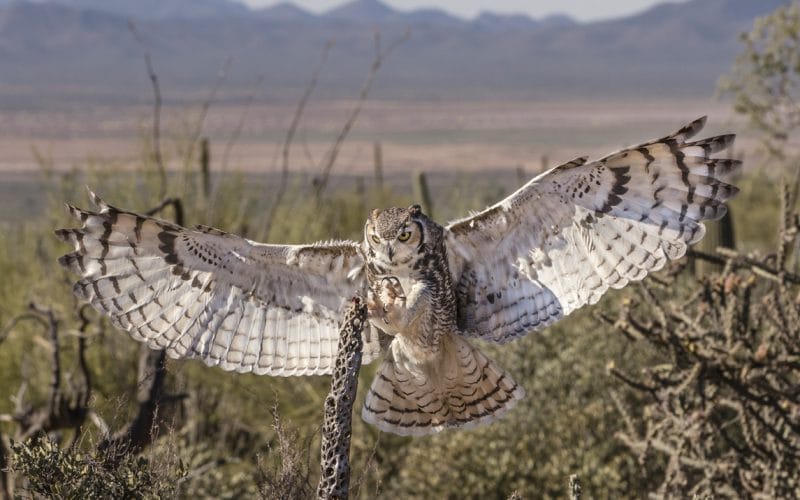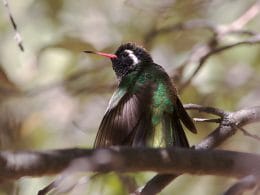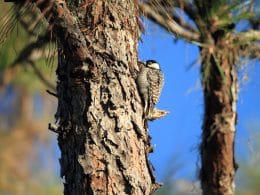Solitary yet majestic, who wouldn’t want to spot owls? If you’re in the Maryland area and want to catch a glimpse of these hooting birds, well you’re in luck.
There’s a fair number of owls in Maryland to birdwatch. Looking for them might be difficult at first since they’re naturally nocturnal and not to mention deathly quiet as they stalk for prey.
Once you’ve caught a glimpse of its abnormally large eyes, by all means, remain still and admire it in all its feathery glory.
Stick around if you want to learn more about the owls in Maryland and how you can identify each one.
9 Owls to See in Maryland
There are around nine owl species you can locate in Maryland. Some may look similar, but there are always some telltale signs to correctly guess which species it belongs to.
Without further ado, let’s dive in and explore them all. It’s going to be a hoot!
1. Long-eared Owl

- Scientific Name: Asio otus
- Wingspan: 37.4 inches
- Size: 12 to 16 inches in length
- Weight: 8.8 to 11.5 oz
This owl will seem just as surprised to see you. Its long ears give it a permanently startled expression.
With that kind of hearing, Long-eared Owls can easily lock their prey and dive in for the kill. You might struggle to find these owls because of how well they blend with their surrounding foliage.
Speaking of their surroundings, you’ll most likely find these Long-eared Owls in evergreen shrubberies and trees.
If you have your ear out trying to listen to their hoots, you might confuse them for low barking sounds. That being so, the best method of locking eyes with this owl is to hear their hoots. They’re so loud you can practically hear them from 0.7 miles away.
Top Tip: To grab a long-eared owl’s attention to your backyard, you could install a nesting box. They won’t mind artificial buckets as well.
Identifying this bird of prey might be tricky since it closely resembles the Great Horned variety. You can attempt to distinguish them apart from the Long-eared Owl’s distinctly slender form.
The owl mostly ventures to Maryland in search of breeding grounds. Unlike most other owls, the long-eared species are friendly with each other. So much so, that they might even share their shelter with others of their kind.
2. Snowy Owl
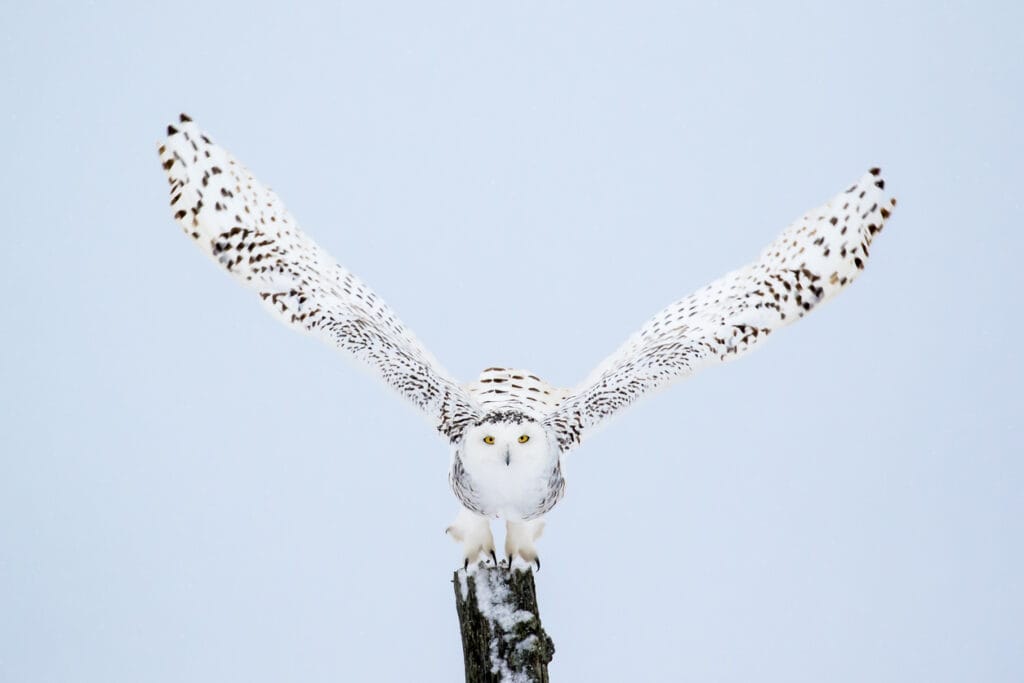
- Scientific Name: Bubo scandiacus
- Wingspan: 48 to 60 inches
- Size: 25 to 29 inches in length
- Weight: 70.5 oz
If you’re a Potterhead, then you’re no stranger to this species (yes, we’re talking about Hedwig). The mighty Snowy Owl is truly a sight to behold.
They’re probably one of the easiest owls to identify when bird watching because of their signature snow-white plumage.
You don’t have to look up to find these white owls. They’re usually nestled on a ground area.
Since they come in winter in Maryland, you might have a hard time trying to pinpoint them, but they’re not all white. You should look out for the black spots speckled on their wings.
Snowy Owls have large unmistakably yellow glaring eyes. They’re always on the hunt for their next prey, which can include rodents and smaller birds.
Contrary to common belief, snowy owls don’t just hoot, they make other sounds. Apart from their guttural hoots, these spotty owls can hiss and whistle as well. Snowy Owls are relatively loud. Since they’re so large, their calls can be heard from approximately seven miles away.
If you decide to annoy these birds, be warned, they’ll make clacking noise with their snapping beaks.
Bottom line, if you’re lucky enough to stumble upon a Snowy Owl, we recommend savoring the moment and keeping your cool. After all, it’s not every day you get to see such a beautiful creature.
3. Short-eared Owl
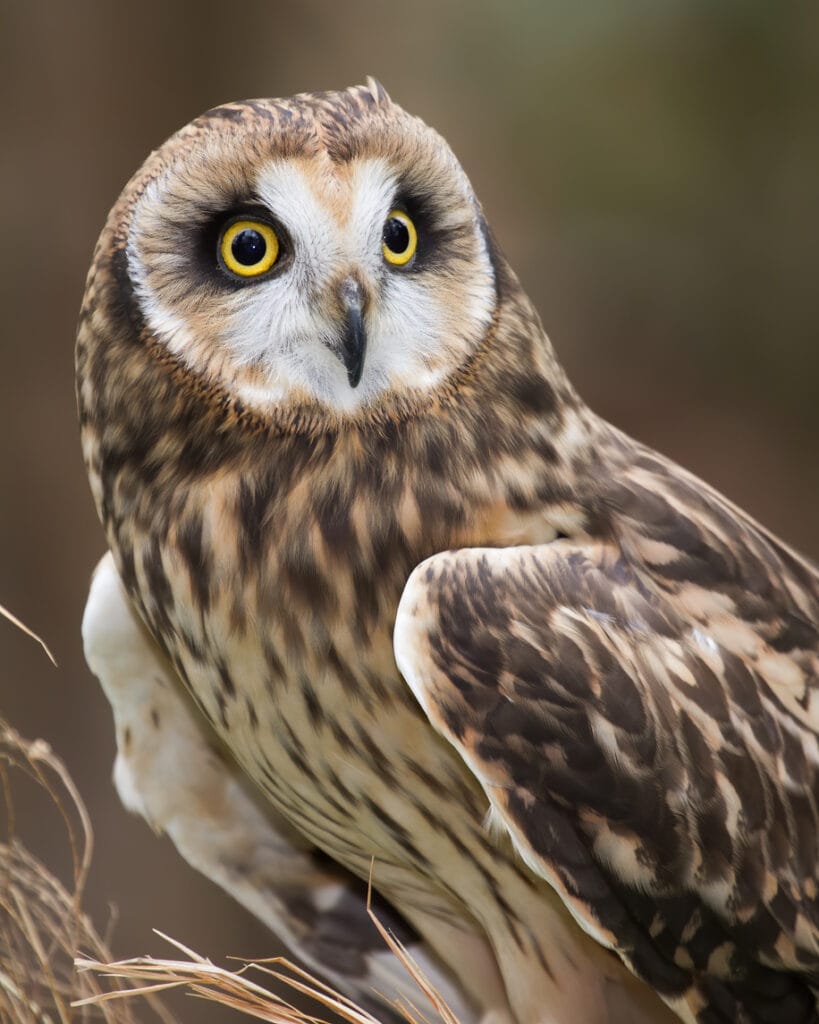
- Scientific Name: Asio flammeus
- Wingspan: 34 to 40 inches
- Size: 13 to 17 inches in length
- Weight: 7 to 17 oz
Owls are famously nocturnal, but there are some exceptions. The Short-eared Owl variety prefers daytime hunting.
Short-eared Owls also stand out from their flying style. They zoom in on their prey in a moth-like fashion, making them virtually undetectable to any unsuspecting prey.
The species always goes for the voles among other rodent prey. These owls, like the snowy type, also shelter on ground level, especially in tall grass areas, marches, and meadows.
Their striking yellow eyes are framed by an intense dark outline, almost panda-like. Their feathers are mostly earth-colored and have black spots. There are some white feathers blotched around here and there. Meanwhile, Their face discs are white.
An interesting defense technique the short-eared owl does is that it defecates on its eggs to ward off any suspicious predators.
Short-eared Owls don’t have a typical hoot, instead, it sounds like a cat’s mating call. If you hear it, you could also think it’s a chicken clucking or a dog softly barking. They barely make much noise. You’ll mostly hear them if it’s the mating season or if they’re fighting off oncoming intruders.
The good news is that these owls are one of the most commonly found ones since they’re significantly spread out. They’re also easier to spot since they appear during the daytime.
4. Great Horned Owl
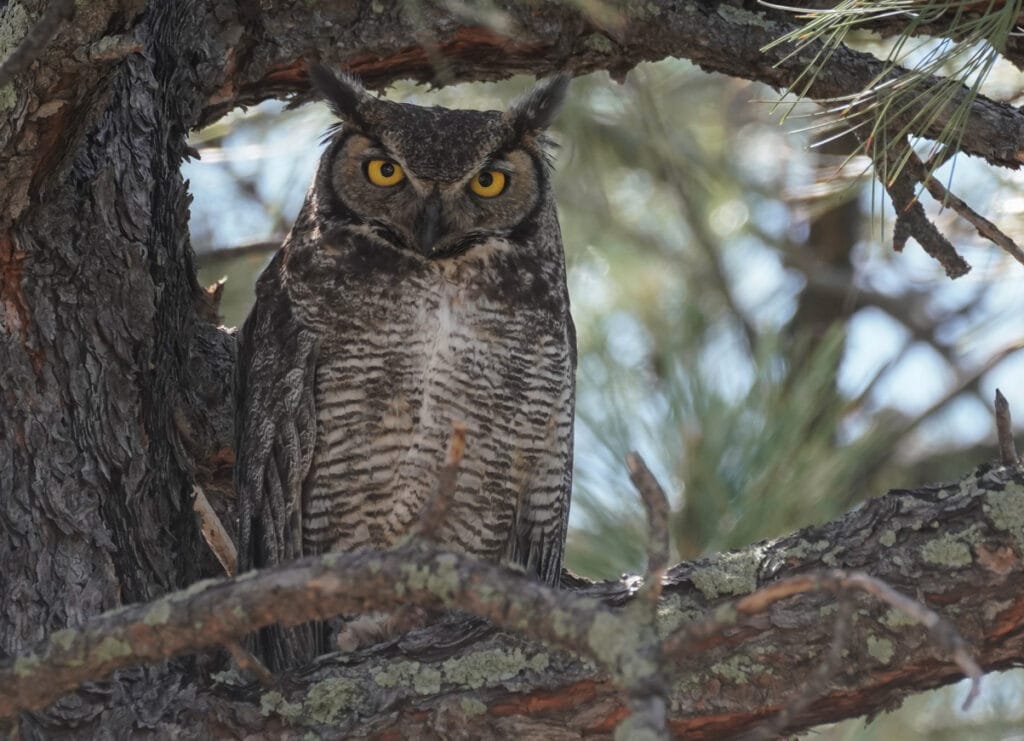
- Scientific Name: Bubo virginianus
- Wingspan: 55 inches
- Size: 18 to 25 inches in length
- Weight: 49 oz
If you’re a beginner bird watcher, Great-horned Owls are a great start. They’re easy to recognize since they practically shelter anywhere.
Great Horned Owls are also sustainable creatures. You can find them reusing an old crow, squirrel, or hawk’s nest.
They’re not just versatile with their shelter, but also with their feeding habits. They can munch on anything they can get their talons on, rodents, reptiles, amphibians, small birds, squirrels, and rabbits.
When it comes to looks, this owl doesn’t disappoint. You’ll be able to distinguish the great-horned species from its intensely furrowed eyebrows. Underneath those bushy brows lies a couple of lime-yellow irises.
This owl has one of the most generic hooting sounds. It’s easy to pinpoint its sound. During breeding, you might hear a couple of owls dueting. That being said, if they’re threatened, they’ll most likely clack their beaks in an attempt to warn trespassers.
5. Eastern Screech-Owl
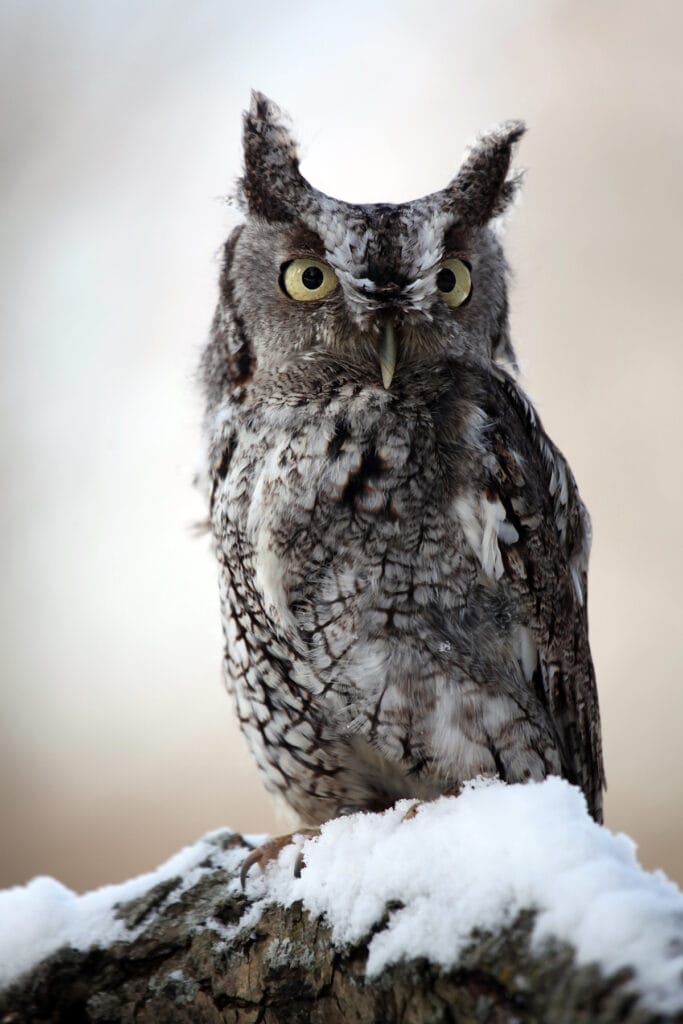
- Scientific Name: Megascops asio
- Wingspan: 19 to 24 inches
- Size: 6 to 10 inches in length
- Weight: 5.6 oz
You can find this little fella can be found all year round in Maryland. They’re the most adorable of the bunch, with their petite frame and virtually non-existent neck.
Eastern Screech-Owls have richly-colored feathers. A couple of varieties showcase different colors. For instance, some are almost a ginger brown color, while others are mostly gray, which is ideal for hiding from bigger predators.
The owls also have wisps of feathers coming out of the top corners of its face. It accentuates its face, giving it that wise old owl look.
Author Note: Eastern Screech-Owls prefer sheltering in trees during the daytime, as they await their night hunts. Even though this owl is small, you can easily see them around the woods.
Apart from that, the main question on your mind might be, why are they called “screech owls”? Well, they don’t exactly hoot as much as chirp a whinnying tone. You might even confuse their sounds for a common warbler.
6. Barn Owl

- Scientific Name: Tyto furcata
- Wingspan: 39 to 49 inches
- Size: 12.5 to 15.7 inches in length
- Weight: 15 to 21.8 oz
This is one classic-looking owl. Barn Owls almost look like they were taken out of a fairytale. Their face shape is eccentric but also efficient.
Barn Owls have a heart-lined forehead with a large V-shaped noise cutting between their eyes. This face shape allows sound to travel to their ears more accurately.
That’s why their prey have no chance of getting away. Barn Owls can hear the most minor rustles on the forest bed. On top of that, their prey include the usual rodents, voles, and more interestingly, bats.
If you’re looking for a Barn Owl, it’s safe to say you might find them perched in a farm region somewhere in a barn, scouting for their food.
Their feathers are coffee-colored and have several notes of milk-white along with darker, burnt hues.
These owls don’t sound like your traditional hooting owl. On the other hand, barn owls give off an alarming screech, which sounds like someone screaming for help.
7. Burrowing Owl
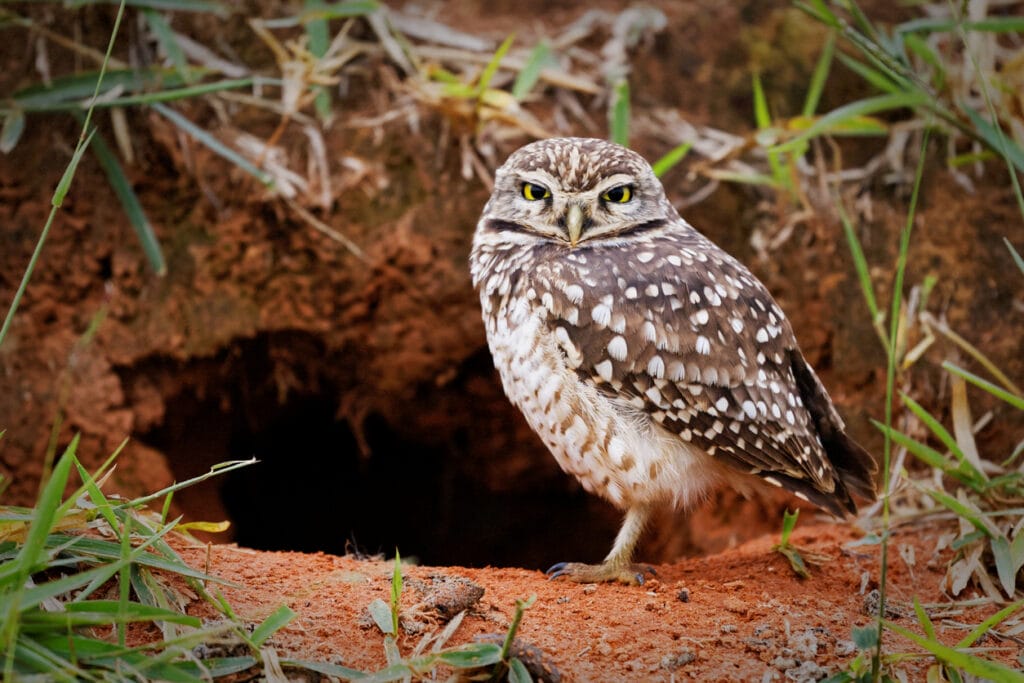
- Scientific Name: Athene cunicularia
- Wingspan: 20 to 24 inches
- Size: 7 to 10 inches in length
- Weight: 5.2 oz
Burrowing Owls are fond of open spaces. They’d much rather forage for their prey on ground level during the night.
They can also be active during the day. This means that you might be able to see it both at sunrise and sundown.
Their heads are round and equipped with laser-focused, large yellow eyes. Appearance-wise, burrowing owls are brown-based with white spots on their wings. Their chests are mostly white.
You can look for Burrowing Owls in grasslands, prairies, or even at the airport. They appear in Maryland during the colder months.
These owls are natural burrowers, which is where their name comes from. Their long legs make digging up their shelter holes much easier.
If you’re trying to use your ears to detect a Burrowing Owl, you might struggle since these owls have a warbling sound that can be easily mistaken for other birds.
8. Barred Owl
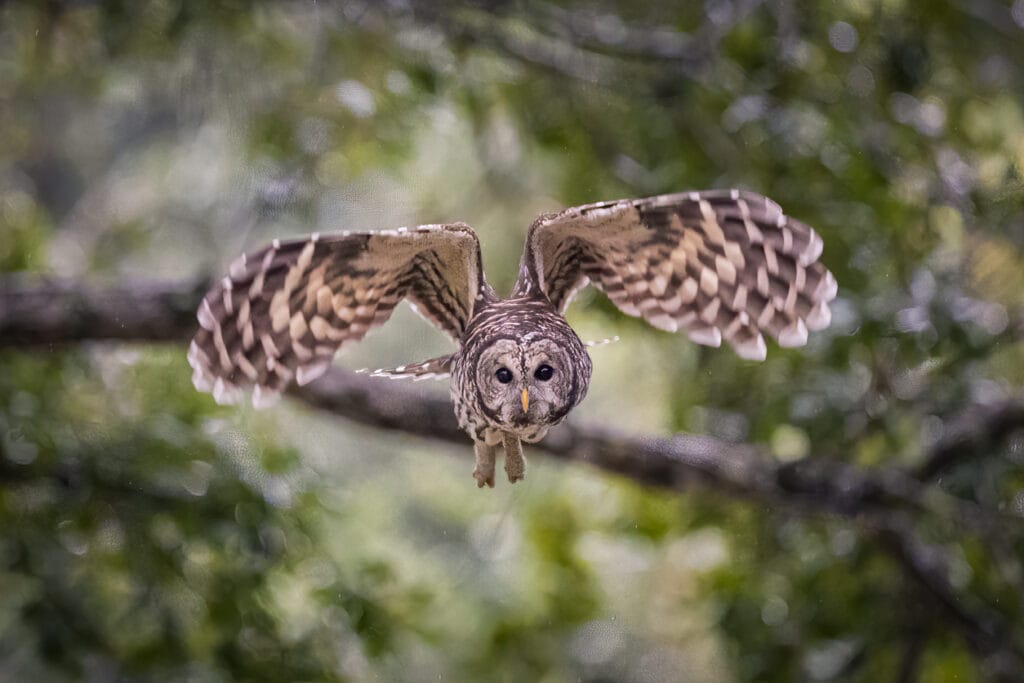
- Scientific Name: Strix varia
- Wingspan: 43 inches
- Size: 19 to 20 inches
- Weight: 22 to 28 oz
Barred Owls get their name from their brown and white striped plumage, which looks like bars.
Unlike other owls listed here, this one has completely black orbs, where you can barely see their pupils. They do have something yellow though, their minuscule beaks.
These are the deadliest owls since they don’t have predators stalking them around unless you count us.
Barred Owls will snatch anything deemed prey-worthy such as mice, rodents, squirrels, and rabbits.
The apex owl has one of the most noteworthy calls. The notes sound like this, “who cooked for you? Who cooked for you all?” If you hear something along those lines, you might be listening to a barred owl’s call.
9. Northern Saw-whet Owl
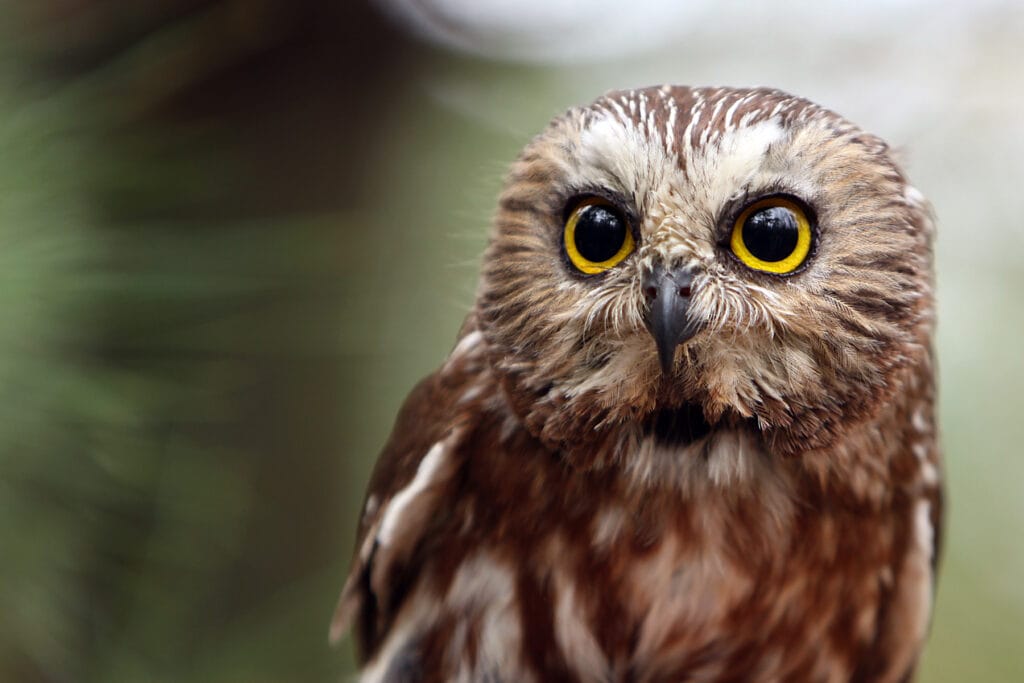
- Scientific Name: Aegolius acadicus
- Wingspan: 18 to 24 inches
- Size: 7 to 8.6 inches in length
- Weight: 3.5 oz
If you haven’t heard of the Northern Saw-whet Owl, allow us to introduce you to one of the tiniest owls on this list.
While they are exceptionally small in size, their yellow eyes are eerily large and circular, almost staring into your soul.
Northern Saw-whet Owls have mocha-colored feathers with the occasional white tufts spread out over their wings. The center of their faces is mainly white but branches out to a brownish color, before mixing with the white.
Author Note: This owl has a lot in common with the Eastern Screech-Owl since both of them are active at night, but rest and burrow during the daytime.
This bird has an interesting family dynamic compared to other animal species. It continuously looks for mates to breed with despite already laying and hatching eggs. The male is usually one caring for these eggs in their nests.
You might have to look closer if you’re trying to track down these owls. What’ll mostly help is the unique sound they emit.
The owl is named after the sound it makes, which is when a saw is sharpened or whetted. Northern saw-whet owls give out high-pitched two-note calls or “too-too”.
To Conclude
If you’re a birdwatcher in Maryland and have a particular affinity towards owls, you’re in luck. There are several kinds you can look out for. You might want to search for them while on your morning or night hike.
If you want to attract them to your yard, we recommend keeping a box out for them to nest in. If your lawn is unkempt, that’s even better since owls have a better chance of hunting their prey in taller grass. Happy birdwatching!
FAQ
A good place, according to Audubon, for the Northern Saw-whet Owl is the Sandy Point State Park.
The Short-eared Owl is probably the most widespread owl in Maryland.
To find out where recent sightings of owls have been, try eBird. You can search for the latest sightings or particular species or what has been seen in a certain area.




